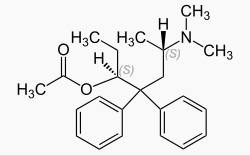Levacetylmethadol
 | |
| Clinical data | |
|---|---|
| Routes of administration | Oral |
| ATC code | |
| Legal status | |
| Legal status |
|
| Pharmacokinetic data | |
| Protein binding | ~80% |
| Metabolism | CYP3A4 |
| Elimination half-life | 2.6 days |
| Identifiers | |
| |
| CAS Number | |
| PubChem CID | |
| DrugBank | |
| ChemSpider | |
| UNII | |
| KEGG | |
| ChEMBL | |
| E number | {{#property:P628}} |
| ECHA InfoCard | {{#property:P2566}}Lua error in Module:EditAtWikidata at line 36: attempt to index field 'wikibase' (a nil value). |
| Chemical and physical data | |
| Formula | C23H31NO2 |
| Molar mass | 353.498 g/mol |
| 3D model (JSmol) | |
| |
| |
| | |
|
WikiDoc Resources for Levacetylmethadol |
|
Articles |
|---|
|
Most recent articles on Levacetylmethadol Most cited articles on Levacetylmethadol |
|
Media |
|
Powerpoint slides on Levacetylmethadol |
|
Evidence Based Medicine |
|
Cochrane Collaboration on Levacetylmethadol |
|
Clinical Trials |
|
Ongoing Trials on Levacetylmethadol at Clinical Trials.gov Trial results on Levacetylmethadol Clinical Trials on Levacetylmethadol at Google
|
|
Guidelines / Policies / Govt |
|
US National Guidelines Clearinghouse on Levacetylmethadol NICE Guidance on Levacetylmethadol
|
|
Books |
|
News |
|
Commentary |
|
Definitions |
|
Patient Resources / Community |
|
Patient resources on Levacetylmethadol Discussion groups on Levacetylmethadol Patient Handouts on Levacetylmethadol Directions to Hospitals Treating Levacetylmethadol Risk calculators and risk factors for Levacetylmethadol
|
|
Healthcare Provider Resources |
|
Causes & Risk Factors for Levacetylmethadol |
|
Continuing Medical Education (CME) |
|
International |
|
|
|
Business |
|
Experimental / Informatics |
Editor-In-Chief: C. Michael Gibson, M.S., M.D. [1]
Overview
Levacetylmethadol (INN), levomethadyl acetate (USAN), OrLAAM (trade name) or levo-α-acetylmethadol (LAAM)[1] is a synthetic opioid similar in structure to methadone. It has a long duration of action due to its active metabolites. It was approved in 1993 by the U.S. Food and Drug Administration for use in the treatment of opioid dependence. In 2001, Orlaam was removed from the European market due to reports of life-threatening ventricular rhythm disorders.[2] In 2003, Roxane Laboratories, Inc. discontinued Orlaam in the US.[3]
Indications
LAAM is indicated as a second-line treatment for the treatment and management of opioid dependence if patients fail to respond to drugs like methadone or buprenorphine. Before August 1993, LAAM was classified as a schedule I drug in the United States. LAAM is not approved for use in Australia and Canada. At present, it is a Schedule II Narcotic controlled substance in the United States with a DEA ACSCN of 9648 and a national aggregate annual manufacturing quota of 4 grammes as of 2013.
Chemistry and pharmacology
Levacetylmethadyl acts as a mu-opioid receptor agonist. It also acts as a potent, noncompetitive α3β4 neuronal nicotinic acetylcholine receptor antagonist.[4]
Levomethadyl acetate is the levo isomer of α-methadyl acetate. The dextro isomer, alphacetylmethadol, is more potent but shorter acting. The levo isomer is also less toxic with an Template:LD50 in mice of 110 mg/kg s.c. and 172.8 mg/kg orally as opposed to Template:LD50s of 61 mg/kg s.c. and 118.3 mg/kg orally for dl-α-methadyl acetate. It has a melting point of 215 °C and a molecular weight of 353.50. β-methadyl acetate also exists, however it is more toxic and less active than α-methadyl acetate and has no current medical use.
Levomethadyl acetate undergoes extensive first-pass metabolism to the active demethylated metabolite nor-LAAM, which is further demethylated to a second active metabolite, dinor-LAAM. These metabolites are more potent than the parent drug.
Dosing
LAAM is used as an oral solution of levomethadyl acetate hydrochloride at a concentration of 10 mg/mL in bottles of 120 and 500 mL under the brand name Orlaam. The first dose of LAAM for patients who have not started treatment with methadone is 20–40 mg. The first dose for patients who have been receiving methadone will be a little higher than the amount of methadone that was being taken every day, but not more than 120 mg. Afterwards, the dosage may be adjusted as needed. Unlike methadone, which requires daily administration, LAAM is administered two to three times a week.
See also
References
External links
- Pages with script errors
- Articles with changed DrugBank identifier
- Articles with changed ChemSpider identifier
- Articles with changed EBI identifier
- E number from Wikidata
- ECHA InfoCard ID from Wikidata
- Articles with changed InChI identifier
- Chemical articles with unknown parameter in Infobox drug
- Drugboxes which contain changes to verified fields
- Drugboxes which contain changes to watched fields
- Drug
- Synthetic opioids
- Enantiopure drugs
- Amines
- Acetate esters
- Mu-opioid agonists